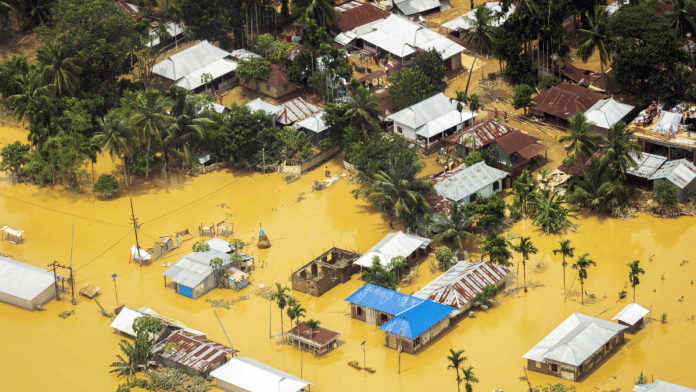New Delhi: One-third of the world’s population—nearly 2.7 billion people—is currently vulnerable to coastal or inland flooding, according to a report by Moody’s. In India alone, 622.1 million people are exposed to the risk of inland flooding and 47.92 are vulnerable to coastal flooding, it said.
The report, An Integrated Approach to Evaluate Population Exposure to Inland and Coastal Flooding, published on 25 September, analyses flood risk around the world between 1975 and 2030 using two global datasets: one on population growth and the other on the severity of flooding globally. Moody’s is a global financial and risk analytics research corporation.
According to the report, South Asia is at the highest risk for flooding with over 40 percent of the population living in regions susceptible to inland flooding and 5 percent to coastal flooding at a 100-year return period level. This means that every year, there is a 1 percent chance that South Asia will experience severe flooding.
“As flooding continues to pose a growing threat, understanding the populations most vulnerable to its effects is paramount for effective disaster management and mitigation efforts,” the report said.
Globally, India is the most at risk of inland flooding and the third-most at risk of coastal flooding based on the number of people at risk. Around 240 million people across the world, of whom 19.9 percent are Indians, are vulnerable to coastal flooding. 2.4 billion are at risk of inland flooding; that is, fluvial (river) and pluvial (flash) flooding.
In absolute numbers, the five countries most vulnerable to both types of flooding are in Asia with India, Bangladesh, and China featuring on both lists. The report said that the large population size of the three countries is a reason they are ranked so high on the list.
However, as a percentage of the population, Suriname and Guyana in Latin America, with 92 and 77 percent of their populations at risk of inland flooding respectively, are the worst-affected countries.
The reason for this, it said, is the concentration of their populations—almost half the total population of Suriname lives in Paramaribo, the capital city, which is entirely susceptible to inland floods at a 100-year return period. Similarly, the majority of Guyana’s populace is concentrated in coastal areas which are at the highest risk.
Similarly, at 76 and 54 percent of their populations respectively, Tuvalu in Oceania and Guyana are countries with the highest number of people at risk of coastal flooding.
As a result of “a complex interplay of climate change, urbanisation, and land-use practices,” the Moody’s report said, the proportion of people who live in areas at risk of flooding has grown rapidly since 1975.
The risk of flooding, it added, has risen at a higher rate than the growth rate of populations at risk across every region of the world—South Asia, Africa, Europe, and Oceania.
Moody’s analysis further shows that between 2024 to 2030, the percentage of people at risk of floods will rise even more in every region, except Europe and North Asia, where it is expected to dip after 2025.
Also Read: Gujarat flooded, eastern India parched & no ‘monsoon breaks’. IMD predictions hit the mark
Flood return periods & impact of defences
The report used a Global Flood Data and Maps database put together by Moody’s Risk Management System (RMS) for its analysis. The database contains information on flooding based on a variety of factors, including the probability of occurrence, expected flood depth, and the presence of defences against floods in different countries. However, the database does not account for climate change or socio-economic changes in its calculation of flood risk.
At a regional level, the analysis showed that the increase in population exposed to flood risk further changes based on the return period of the floods. While less than 10 percent of North America’s population is susceptible to floods at the 10-year return period level, more than 20% of the population is at risk at the 200-year return period level.
The return period is a measure that counts how often a flood of a certain size is expected to occur at a statistical level.
One of the leading explanations for this disparity, the report said, is the difference in preparedness and defences for flooding at different levels. For a flood with a 10-year return level, countries would have more widespread protections, as compared to a flood with a 100-year return level.
However, even within countries, there is an obvious disparity in preparedness levels and defences against floods. For example, while Europe and north Asia still have some percentage of their population that is protected against severe events like 100-year return period flooding, in Africa a negligible percentage of the population has any sort of defence against those events.
The report proposes using the data of flood projections and population concentrations in countries to deploy appropriate flood protection mechanisms.
(Edited by Sanya Mathur)
Also Read: Rainfall that caused Wayanad landslides made 10% more intense by climate change — WWA scientists






